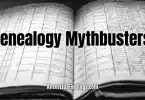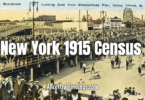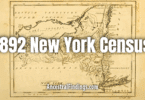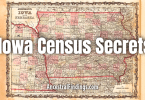By the time the 1850 U.S. Census was taken, the United States was no longer a slow-growing collection of coastal settlements. It was a booming, restless, coast-to-coast land of contradictions. The population had reached over 23 million people. The western frontier had stretched all the way to California. Cities were growing fast, but most people still lived on farms. The railroad and steamboat had made the country feel smaller, even as it grew larger. And in the background, tension over slavery and statehood was rising like a tide that couldn’t be turned back.
Amid all this change, the federal government made one small but radical adjustment to the census: it began listing the names of every free person in the household. For family historians, it’s the moment where the lights come on.
A Name for Everyone (Well, Almost)
Before 1850, the census told us who was living in a household only through tallies in age and gender brackets. The head of house was named—everyone else was a tick mark. That changed in 1850. For the first time, the census gave the name, age, sex, occupation, and birthplace of every free individual. Children were named. Wives and elderly parents were named. Even newborns were recorded if they were born before the census taker arrived.
This change opened the door to all kinds of new discoveries. We could now confirm family groupings, see children in order, catch a glimpse of blended families, and begin to untangle relationships that had been hidden in earlier decades. And because occupations and birthplaces were included, you could start tracing migration paths, economic status, and even social roles.
This was also the first census to ask for the value of real estate—a simple number that often says a lot. A farmer with land valued at $1,200 was living a different life than the one with no property at all. And if someone had no occupation listed and no property, that could raise questions about health, dependency, or life circumstances. In some cases, it might suggest a woman living independently for the first time, or an elderly relative being cared for by younger kin.
Who Was Counted—and Who Wasn’t
The 1850 census counted every free person, but enslaved individuals were still not listed by name. Instead, they were recorded in separate “slave schedules,” which included age, sex, and race—but no names. These schedules named the slaveholder, not the enslaved.
That means if you’re researching ancestors who were enslaved in 1850, it’s not enough to just look at the population schedule. You’ll want to look at the slave schedules for that county and then cross-reference with other records—like wills, inventories, bills of sale, and oral histories—to start building the connections.
For researchers tracing enslaved ancestors, it’s painstaking work. But the 1850 census is one of the earliest places where clues begin to gather—and where you might find a child or young adult listed in a free Black household for the first time.
A Country in Motion
The 1850 census reveals a country on the move. Migration from east to west was at a full gallop. You’ll see families who were born in places like Virginia, now showing up in Missouri or Indiana. New Englanders in Ohio. Tennesseans in Texas. People were going wherever opportunity—or land—took them.
Birthplace columns are especially important here. If the father was born in South Carolina, the mother in Kentucky, and the children in Arkansas, you start to piece together a migration trail. Sometimes I’ll draw a timeline based on where the children were born, which helps me figure out what route the family took and when they likely moved.
This is also a key census for spotting multi-generational households. You might find elderly parents living with grown children, or adult siblings still under one roof. You might see families caring for orphaned nieces or nephews, or newly married couples starting out with a parent living nearby. These arrangements often tell you something about the family’s values, health, or finances.
The Schedule That Changed Research
One of the most powerful things about the 1850 census is how searchable it has become. Since every name was recorded, indexes could be built. That means we can now search by name, making it far easier to find families—even if they moved between states.
For those of us who’ve spent time with earlier censuses, this feels like someone handed us a flashlight. It’s not perfect—ages and spellings can be off, and occupations might be vague—but it gives us a foothold we’ve never had before. When I’m working on a family tree, this census is usually where the puzzle starts to make sense.
I also take time to look at the neighbors. Census takers moved door to door, so the people listed around your ancestor were often their actual neighbors—and sometimes their relatives. You might see a row of siblings, in-laws, or even parents and children spread across three or four households in the same township. In areas with shared surnames, that’s a clue worth chasing.
Genealogy Tips from the 1850 Census
There are so many little details in the 1850 census that get overlooked. Here are some that I keep an eye out for when working with it:
If someone is listed as “attended school within the year,” that tells you a bit about their age and likely literacy. If the column is marked “cannot read or write,” that’s another helpful clue—especially if you’re wondering why someone didn’t leave behind letters, diaries, or even clear signatures in other documents.
If the person was married within the year, it usually means the marriage happened in late 1849 or early 1850—so local marriage records might still be fresh and easy to find.
And that occupation column? It’s worth digging into. Some were listed as farmers, laborers, or merchants, but others were surprisingly specific—millwright, wheelwright, cooper, tailor, midwife, tanner, or schoolteacher. That detail opens the door to apprenticeship records, trade licenses, or town histories.
Finally, don’t ignore the gaps. If someone is missing in 1850 but was there in 1840, or vice versa, there’s a story in that. Maybe they died. Maybe they moved out of state. Maybe they went to California in search of gold. This census is often the starting line for those kinds of discoveries.
Understanding the 1850 Slave Schedules
While the main 1850 population schedule gave names and details for every free person in the United States, those who were enslaved were recorded in a separate document—the 1850 Slave Schedules. These records are harder to work with, and more heartbreaking to read. They didn’t include names for the enslaved, only age, sex, and color (usually listed as Black or Mulatto), along with the name of the slaveholder.
But even with these limitations, there’s information here that can offer critical clues—especially when used alongside other records. For anyone researching African American ancestors, the 1850 census is often the beginning of a long and careful process of piecing together identities from small fragments. That process often starts right here.
Each slave schedule is arranged by county and owner, listing the name of the slaveholder, then showing the individuals they held in bondage by age, gender, and race. You might see a 36-year-old Black male, a 10-year-old Black female, and an infant Mulatto child listed under the name of a single white landowner. None are named, but you begin to build a profile—who was likely in the same household, who might have been a parent, and who may have been a child.
If you’ve found an ancestor who was born into slavery and was freed before the Civil War or shortly after, cross-referencing these schedules with other documents—like wills, estate inventories, probate cases, and manumission papers—can begin to reveal names, relationships, and movements. Sometimes, freed individuals stayed near or worked for their former owners after emancipation, and those names can appear in later censuses or in Freedmen’s Bureau records after the war.
I also recommend looking at the 1850 population schedule alongside the slave schedule for the same county. If a freed Black family appears in the population census, check nearby slaveholding families in the slave schedule. Sometimes a freedman took the surname of the person who once owned their family. Other times, they show up next door or just down the road. These neighborhood patterns can lead to discoveries that official records don’t spell out.
The 1850 slave schedule also lists the number of enslaved persons held, which helps trace the size and scale of slavery in a particular region or community. A small household might show just one or two enslaved people—perhaps a cook or field hand. A larger landowner might have dozens. These counts not only reflect labor and wealth but offer a stark reminder of the scale of human lives affected.
It’s difficult research—but it’s also sacred work. The 1850 slave schedules, as frustrating as they are, hold a window into lives that were recorded only in fragments. When you take the time to study them carefully, cross-match them with other sources, and treat each unnamed entry with the dignity it deserves, you start to build something meaningful out of what was meant to be impersonal.
If you’re researching enslaved ancestors or the families who enslaved them, this part of the 1850 census deserves just as much time and attention. It may not give you everything. But it offers starting points—and sometimes, those are enough to begin uncovering stories that were nearly lost.
My Final Thoughts
The 1850 census wasn’t just a new way to count people—it was the first time the country attempted to see its people more fully. Every free person had a name, an age, a birthplace, and a place in the household. That shift changed everything for family historians. Finally, we could begin to connect generations, trace migration, and understand how people lived—not just where.
But it’s important to remember that the story wasn’t complete. The 1850 census also introduced the first slave schedules, which showed a parallel world of families and individuals whose names were kept off the record, even as their lives and labor shaped the nation. These records are harder to read and harder to work with—but they hold an essential part of the American story. And for those tracing African American ancestry, the 1850 census—both the population and the slave schedule—is often the first place where clues begin to emerge.
Taken together, these two pieces of the census show us a nation in transition. It was a country moving west, growing fast, and beginning to fracture. Families were growing, blending, breaking apart, and starting new chapters. Some were settling down for the first time. Others were moving for the third or fourth time. And each of them—no matter how brief their entry—left a footprint.
For those of us researching our families, this census is more than a tool. It’s a doorway. A place where the names begin. A place where you stop seeing your ancestors as numbers and start seeing them as people. It’s not a perfect record. But it’s a powerful one. And if you treat it with care, it will continue to guide you through the deeper stories waiting to be found.






